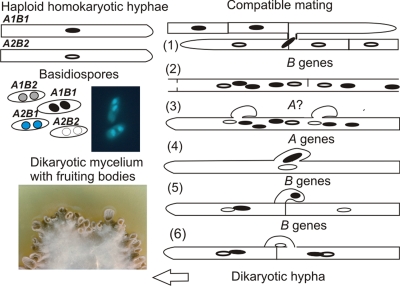Fig. 1.
Life cycle of the tetrapolar basidiomycete Schizophyllum commune. In the fruiting bodies, basidiospores with four different combinations of A and B mating type genes are produced. If both A and B genes are different in two developing, haploid mycelia, a fully compatible mating takes place. (1) B genes regulate the reciprocal nuclear migration, illustrated by movement of a nucleus via a hyphal fusion through broken septa from one haploid hypha into the other. (2) As a consequence of nuclear migration, multinucleate hyphae occur in the interaction zone of the mates. Unfused clamp connections (pseudoclamps) in the multinucleate hyphae are seen as a function of A-regulated development (3), which then controls the pairing of different nuclei followed by the hook cell formation and synchronous nuclear division (4). After separation of the sister nuclei, a cross wall is formed at the base of the hook and in the hypha (5). The growth of the hook toward and the subsequent fusion to the subapical cell are controlled by B genes and allow the movement of the nucleus from the hook into the subapical cell to complete clamp formation (6).

